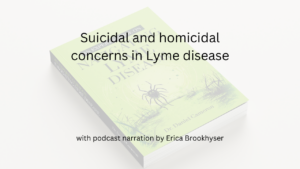Call for your appointment today 914-666-4665 | Mt. Kisco, New York

I will be discussing the risk for children with COVID-19 disease based on a recent paper by Dong and colleagues.
Dong and colleague first discussed this case in the journal Pediatrics in 2020.
Welcome to my next Inside Lyme podcast. – This episode discusses the risk for children with Coronavirus COVID-19.
You may be wondering why I am discussing COVID-19 during an Inside Lyme podcast. I am concerned for my children, grandchildren, and my patients. I would like to share my understanding of COVID-19 though my eyes as a clinical epidemiologist.
I have learned that the best way to understand a COVID-19 infection is through a discussion of actual cases.
I would like to focus on a research paper by Dong discussing 2143 children with COVID-19.
[bctt tweet=”The risk of COVID-19 for children will be the subject of the latest Inside Lyme podcast.” username=”DrDanielCameron”]
Dong and colleagues described these cases in the Journal Pediatrics in 2020.
The paper is titled, “Epidemiological Characteristics of 2143 Pediatric Patients With 2019 Coronavirus Disease in China”
Very few of their pediatric patients with COVID-19 were symptom-free. Only 4.4% of their pediatric patients with COVID-19 were free of symptoms.
Nearly all of their pediatric patients with COVID-19 were ill.
The good news is that half of the children were only mildly ill. They typically presented with “symptoms of acute upper respiratory tract infection, including fever, fatigue, myalgia, cough, sore throat, runny nose, and sneezing.” wrote the authors. Their lungs were clear by auscultation.
A few of their patient had no fever. This is important as a fever is often used to screen for COVID-19.
A few more of their patients had “only digestive symptoms such as nausea, vomiting, abdominal pain and diarrhea.”
wrote the authors. This is an important reminder not to overlook children with COVID-19 who do not have respiratory problems.
The bad news is that over 4 out of 5 of the remaining pediatric patients were either moderately ill, severe, or critical.
Moderate disease
831 children with COVID-19 infections had what the authors defined as moderate disease. These children were ill “with pneumonia, frequent fever, and cough, mostly dry cough, followed by productive cough” wrote the authors. Some had wheezing but did not have shortness of breath. The doctor could hear sputum. Some would have what was referred to as wet snoring. A few of these children were not ill but showed lung lesions on their CXR.
I would imagine it must be difficult for the doctors of these patients with pneumonia to predict which child will progress to severe or critical disease. The actual number of children who progressed is unknown at the time of publication since many of them were still hospitalized.
Severe disease
112 children with COVID-19 infections had what the authors defined as severe disease. These children had started with “early respiratory symptoms, such as fever and chills.” wrote the authors. They added some of them had “gastrointestional symptoms such as diarrhea.”
“The disease usually progressed around one week, and dyspnea occurs, with central cyanosis.” wrote the authors. They added, “Oxygen saturation is less than 92%, with other hypoxia manifestations.”
Critical disease
13 children with COVID-19 infections had what the authors defined as critical disease. These children would “quickly progress to acute respiratory distress syndrome (ARDS) or respiratory failure, and may also have shock, encephalopathy, myocardial injury or heart failure, coagulation dysfunction, and acute kidney injury. Organ dysfunction can be life threatening.” wrote the authors.
Acute respiratory distress syndrome is a life-threatening type of respiratory failure. Fluid builds up in the lung, making it difficult to breath.
Shock is also a life-threatening illness where there is an insufficient blood flow throughout the body.
Encephalopathy is a disease or malfunction of the brain from several causes, including infections, metabolic problems, drugs, or anoxia.
Age
There were children of all ages that presented with severe or critical disease.
The youngest children were the most likely to develop severe or critical disease.
Nearly 7 out of 10 children of their pediatric patients under five years had moderate, severe, or critical disease.
A 14-year-old boy died. The final outcome remains to be determined, as many of the children with COVID-19 remained hospitalized at the time the paper was submitted for publication.
The authors describe several important limitations of the study. Only a third of the children presumed to suffer from COVID-19 were confirmed by laboratory tests. The remaining two-thirds of children were diagnosed clinically. Some of these children may have suffered from other respiratory infections.
In addition, the actual numbers of children with COVID-19 without symptoms is not known. The numbers of children with COVID-19 without symptoms would likely be higher as this study focused on pediatric patients rather than children who were not patients.
Finally, the authors did not clarify how many children had an underlying illness or were immunocompromised.
What can we learn from this cases?
- At least 4 out of 10 pediatric patients with COVID-19 are ill.
- Pediatric patients of all ages can be quite ill. The hardest-hit age group are children under 5.
- Some COVID-19 cases present with gastrointestinal issues rather than respiratory.
- Some COVID-19 cases presented without a fever.
What questions does these cases raise?
- How many children are ill with COVID-19?
- How should these children be treated?
- Will there be any long-term cardiac and pulmonary complications for children who recover?
Inside Lyme Podcast Series
This Inside Lyme case series will be discussed on my Facebook and made available on podcast and YouTube. As always, it is your likes, comments, and shares that help spread the word about this series and our work. If you can, please leave a review on iTunes or wherever else you get your podcasts.
Sign up for our newsletter to keep up with our cases.
References:
- Dong Y, Mo X, Yabin Hu Y, Qi X, Jiang F, Jiang Z, Tonga S. Epidemiological Characteristics of 2143 Pediatric Patients With 2019 Coronavirus Disease in China. Pediatrics.




Thanks for posting & making easily available summaries of pertinent literature – re: TBDs but also COVID-19. Right up your alley as an MD, MPH double-boarded practitoner.